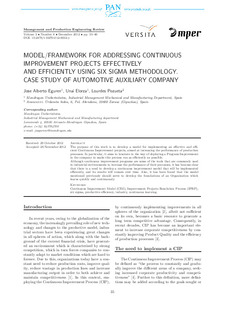Izenburua
Model/framework for addressing continuous improvement projects effectively and efficiently using Six Sigma methodology. Case study of automotive auxialiry companyEgilea (beste erakunde batekoa)
Beste instituzio
Avancex+iBertsioa
Bertsio argitaratua
Eskubideak
© Polish Academy of SciencesSarbidea
Sarbide irekiaArgitaratzailearen bertsioa
10.2478/v10270-012-0032-yNon argitaratua
Management and Production Engineering Review Volume 3. Nº 4. Pp. 35–46,Lehenengo orria
35Azken orria
46Argitaratzailea
Polish Academy of SciencesGako-hitzak
Continuous Improvement Model (CIM)
Improvement Projects Resolution Process (IPRP)
Six sigma
productive efficiency ... [+]
Improvement Projects Resolution Process (IPRP)
Six sigma
productive efficiency ... [+]
Continuous Improvement Model (CIM)
Improvement Projects Resolution Process (IPRP)
Six sigma
productive efficiency
industry
continuous learning [-]
Improvement Projects Resolution Process (IPRP)
Six sigma
productive efficiency
industry
continuous learning [-]
Laburpena
The purpose of this work is to develop a model for implementing an effective and efficient Continuous Improvement projects, aimed at increasing the performance of production processes. In particular, ... [+]
The purpose of this work is to develop a model for implementing an effective and efficient Continuous Improvement projects, aimed at increasing the performance of production processes. In particular, it aims to innovate in the way of deploying a Program Improvement in the company to make this process run as efficiently as possible. Although continuous improvement programs are some of the tools that are commonly used in industrial environments to increase the performance of their processes, it has become clear that there is a need to develop a continuous improvement model that will be implemented efficiently, and its results will remain over time. Also, it has been found that the model mentioned previously should serve to develop the foundations of an Organization which learns quickly and continuously. [-]
Bildumak
Item honek honako baimen-fitxategi hauek dauzka asoziatuta:























